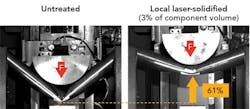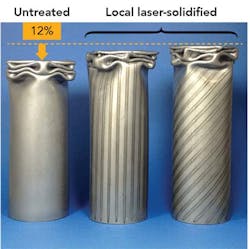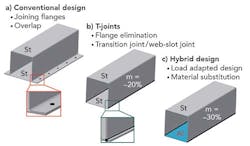Innovative laser processes for lightweight constructions
Laser remote welding provides local strengthening of steel sheets and multi-material design
JENS STANDFUSS, AXEL JAHN, MARKUS WAGNER, JOERG BELLMAN, and ECKHARD BEYER
Increasing challenges to match the requirements of lightweight design and cost-effective production technologies—including the trend to be more design-derivative and to lower lot size—need easy and flexible production processes, and laser remote welding technology can be one solution. Lightweight concepts for automotive structures using metallic hybrid concepts, like aluminum-steel structures as well as local adapted strength distribution, are becoming more and more interesting. Controlled laser remote processes can be used for direct joining of aluminum-steel T-joints and local laser-hardening tracks improve the crash performance of steel profiles significantly.
Local laser strengthening for adapted lightweight design
Locally stressed components are, however, often oversized because the wall thickness must be designed according to the highest load. In low-stress areas, the plate thickness is greater than necessary, resulting in an unnecessarily high component weight. In addition, a wide range of expensive, strong steels with good formability have been developed. But currently, there is always a compromise between component mass and component costs, and crash safety needs to be addressed.
To precisely tune the properties of body components to local loading conditions, a novel approach is followed by laser strengthening with flexible remote technology. The high hardness at remelting tracks or bead-on-plate weld tracks leads to tensile strength of more than 1500MPa, depending on the hardening potential of the treated steel. That's about twice the untreated base material. This is especially important testing bending stress of crash-loaded parts like front and rear shock carriers, B-pillars, and various stiffening profiles, which can be designed to optimize weight and load.
With the help of numerical simulation, a crash-optimized track design for bending stress may occur. Track designs include, for example, a frontal impact on a tree or a side impact. Using the laser remote technology, the track design has been transferred to real components. They were able to halve the deflection of a local laser-solidified tubular profile compared to the reference, although only about 3% of the component volume was hardened locally (FIGURE 1).
At the same time, the failure behavior can be influenced by the position of the first plastic deformation specified by arrangement of the laser strengthening tracks (FIGURE 2).
Multi-material design by laser remote welding
The production of hybrid components with good mechanical properties requires completely new joining approaches, especially with respect to the laser application. Steel-aluminum web-slot joints by selected laser melting can be one solution. For the realization of a direct joining process, especially of hybrid T-joints, a controlled laser remote process has been combined with a new integral design approach. The formation of intermetallic phases can be avoided by a selective melting process. This includes a highly controlled laser remote process to perform selective melting only of the low melting material. Specifically, the joint design of the aluminum side needs to be adapted. To meet this objective, a laser-compatible web-slot construction design for T-joints has been developed (FIGURE 3).
By optimizing the laser remote process, different joint geometries can be realized. Basically, the scanning width, scanning speed, and laser power have been adjusted to melt only the aluminum side (FIGURE 4a). Furthermore, optimization of the one-sided laser process also allows the shaping of a two-sided aluminum form fit (FIGURE 4b). Metallurgical analysis shows small and uncritical intermetallic phases in the boundary area between steel and aluminum. Within the strength-relevant cross sections ("laser rivet head"), no critical iron content was detected.
For components like rocker panels, chassis beams, and bumpers, it is state-of-the-art to perform resistance spot welds, typically with 20mm overlap flanges for welding. To meet the conventional dimensions for structural car body components, a spot-welded steel-steel reference crash profile measuring 80 × 80 × 900 mm with 20 mm overlap flanges has been defined. Due to these new laser technologies, overlap flanges can be eliminated and component weight can be reduced by approximately 20%. For additional weight reduction, the low-stress loaded steel cover sheet was replaced by an aluminum sheet, which leads to a further weight decrease of 10% (FIGURE 5).
In comparison to conventional spot-welded design, crash test results show that the loss of bending stiffness, resulting from the welding flange elimination at the hybrid parts, can be compensated by a higher structural stiffness of the joints. This is caused by the substitution of punctual connections (spot welding) by linear welds (web-slot joint). Furthermore, three-point crash tests showed that even a reduction of deflection is achievable with additional local laser strengthening of the hybrid structure (FIGURE 6).
JENS STANDFUSS([email protected]), AXEL JAHN, MARKUS WAGNER, JOERG BELLMAN, andECKHARD BEYER are all with the Fraunhofer Institute for Material and Beam Technology (IWS), Dresden, Germany; www.iws.fraunhofer.de.






